|
The picture shows the
general view of the Baroncelli Chapel in the Santa Croce in Florence with frescoes
and the stained glass windows by Taddeo Gaddi, altarpiece by Giotto.
General view of the
Baroncelli Chapel :: :: 1328-30
Fresco :: :: Cappella Baroncelli, Santa Croce, Florence
|
|
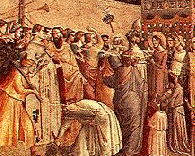 |
|
The upper part of the
fresco cycle depicts the scenes Joachim Driven from the Temple and the Annunciation
to Joachim.
Life of the Virgin
(detail) :: :: 1328-30
Fresco :: :: Cappella Baroncelli, Santa Croce, Florence
|
|
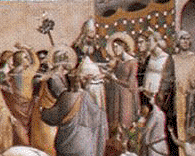 |
|
Taddeo Gaddi, one of
Giotto's pupils painted the Baroncelli Chapel in the church of Santa Croce in Florence
around 1328, brilliantly employing the technical achievements of his teacher. His
scenes for the Life of the Virgin were painted with two goals in mind. First, to
compose the painting so that it corresponded to the form of the chapel bay, which
was arched. Second, by means of the architecture of the painting itself, to create
a sufficiently deep stage for the sequence of events to be played out. Gaddi came
up with an ingenious solution for the upper section directly under the arch. He placed
the architecture of the temple directly beside a cliff which looms up on the right
so that in the the upper section a quatrefoil shape is created, an open space out
of which he let an angel descend. This served to link the scenes Joachim Driven from
the Temple and the Annunciation to Joachim.
The sections below, with their alternating interiors and exteriors, appear as sets
in front of which, and in which, the events take place. From the Meeting at the Golden
Gate (top left) we move on to the Birth of St John the Baptist, the Virgin on her
Way to the Temple, and finally the Betrothal to Joseph. As in San Francesco in Assisi,
the architecture of the painting is closely linked to the architecture of the church,
the continuous narrative to the way a viewer reads.
Life of the virgin
:: :: 1328-30
Fresco :: :: Cappella Baroncelli, Santa Croce, Florence
|
|
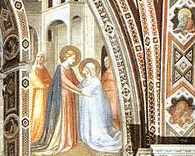 |
|
Life of the Virgin
(detail) :: :: 1328-30
Fresco :: :: FrescoCappella Baroncelli, Santa Croce, Florence
|
|
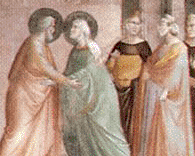 |
|
The upper part of the
fresco cycle depicts the scenes Joachim Driven from the Temple and the Annunciation
to Joachim.
Life of the Virgin
[detail] :: :: 1328-30
Fresco :: :: Cappella Baroncelli, Santa Croce, Florence
|
|
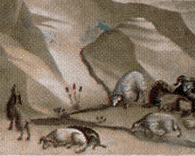 |
|
The Angelic Announcement
to the Sheperds :: :: 1327-30
Fresco :: :: Cappella Baroncelli, Santa Croce, Florence
|
|
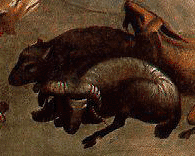 |
|
Gaddi was commissioned
by the rich Baroncelli family to decorate their chapel in the Santa Croce, the Franciscan
church, in Florence. The frescoes depict the life of Mary. This painting shows the
scene when the three years old Mary is presented in the Temple of Jerusalem. The
scene is dominated by the imposing church architecture of the church. The perspective
is represented by the different size of the figures, arranged around a circle.
Presentation of Mary
in the Temple :: :: 1327-30
Fresco :: :: Cappella Baroncelli, Santa Croce, Florence
|
|
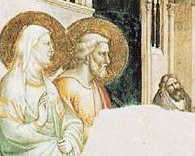 |
|
Stigmatization of
St Francis
Glass window :: :: Cappella Baroncelli, Santa Croce, Florence
|
|
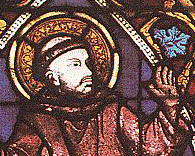 |
|
The huge fresco in the
refectory of the Santa Croce illustrates the allegory of the redeeming (the Tree
of Life), a popular subject of the Franciscans. At the end of the branches the prophets,
holding scrolls with their prophecies, can be seen.
Allegory of the Cross
Panel :: :: Santa Croce, Florence
|
|
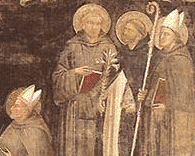 |
|
Life of the Virgin
:: :: 1328-30
Fresco :: :: Cappella Baroncelli, Santa Croce, Florence
|
|
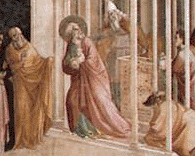 |
|
This painting and the
small Berlin triptych of 1353 are the only signed and dated works by Taddeo Gaddi
that have survived, works that are therefore highly important for establishing a
point of reference for this master's late style. The figures of St Mary Magdalen
and St Catherine are seen standing on each side of the Virgin. The coat of arms of
the Segni family appears on the base of the throne.
Taddeo Gaddi worked with Giotto for twenty six years. He was responsible for popularising
the master's style and laid the foundations on which the painting of the second half
of the fourteenth century was built.
Like other contemporary artists, Gaddi attempted to fuse the two great cultural sources
represented by Giotto and Ambrogio Lorenzetti; the result is a nobly oratorical style,
with little emphasis on the narrative dimension, and a dissolving of Giottesque drama
into a dignified yet academic oratory. A serene monumentality pervades the entire
composition.
The work is highly important for our understanding of Taddeo Gaddi's late style for
it seems to reflect a period of uncertainty, perhaps of crisis, towards Giottesque
models.
Madonna and Child
Enthroned :: :: 1355
Tempera on wood :: :: Galleria degli Uffizi, Florence
|
|
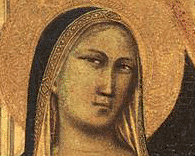 |
|